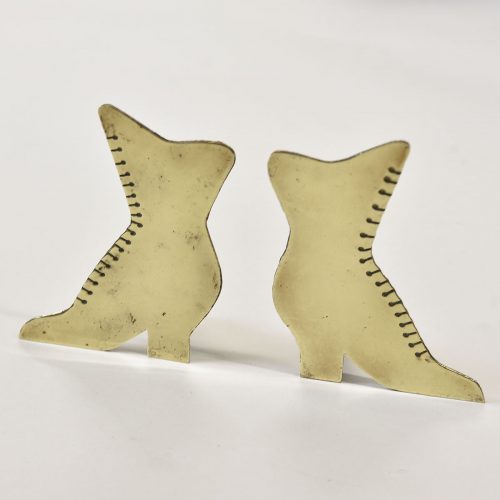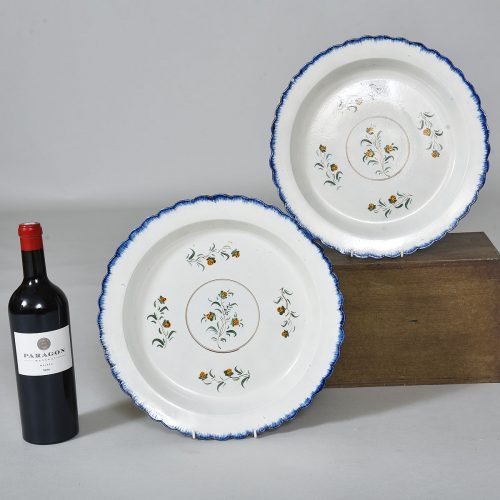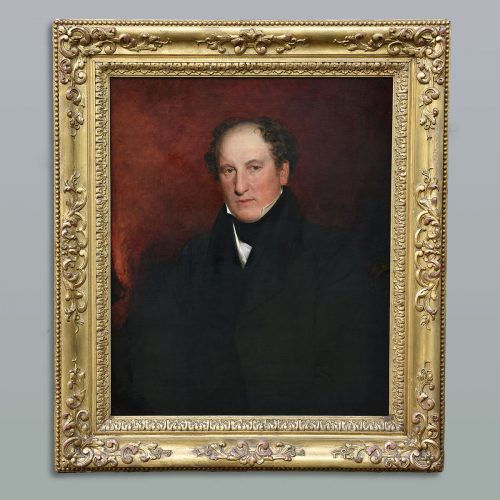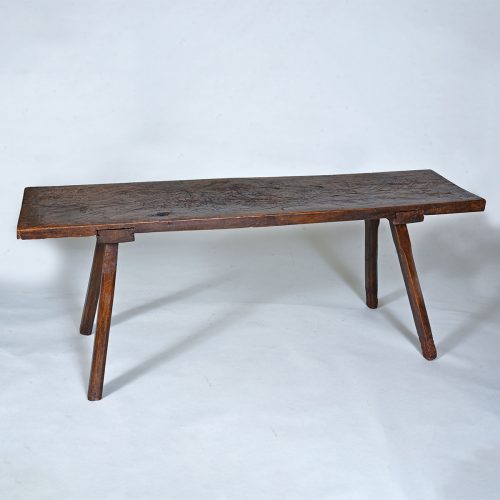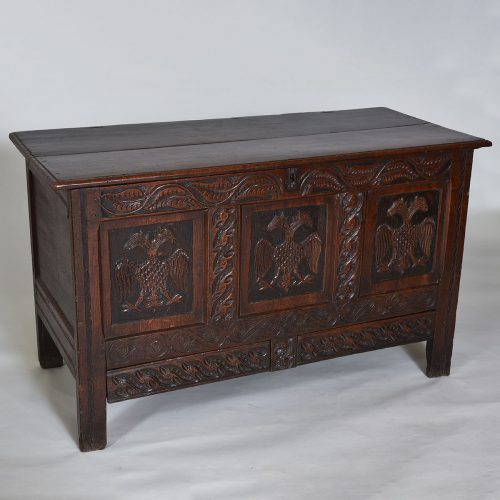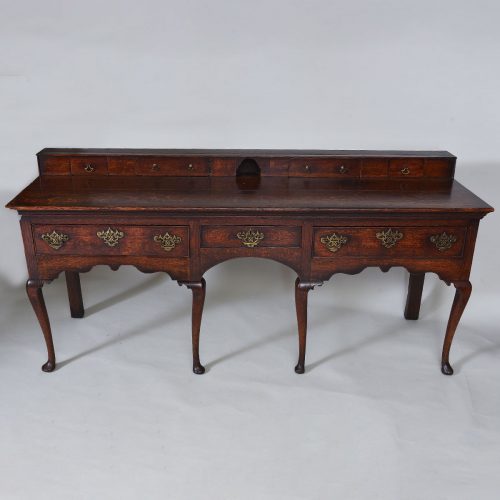Current Stock
-
Pair of Victorian brass shoes Width: 4" / 10 cms Height: 5" / 13 cms
-
Pair of English pearlware pottery chargers with shell edge and scattered flower decoration in Pratt colours. Circa 1815. Diameter: 13.25" / 34 cms
-
Pair (or can be split) of Italian painted and gilded, carved wooden picture frames. Would make excellent mirrors. Width: 35.5" / 90 cms Height: 28" / 70 cms £495 Each
-
Portrait of a Gentleman
£2,950.00Oil on canvas in carved and gilded frame. Portrait of Charles Goodall, founder of Charles Goodall and Sons. The company were the largest producers of playing cards in the 19th century, making three quarters of all those made This portrait hung in the Goodall factory from around 1840 until the closure of the works in 1922. It was subsequently kept in the family until recently. Relined. Framed Size: Width: 34" / 86 cms Height: 39.5" / 100 cms -
SOLD
Portrait of a Young Man
£1,850.00Oil on Canvas. Attributed to Theophilus Clarke (1776-c.1832) Original Giltwood Frame. Portrait of Charles Gordon as a young man, dressed in fashionable Georgian attire. Provenance: Property of the Morland Family, Court Lodge, Kent Width: 28" / 71 cms Height: 33" / 84 cms -
Primitive Antique Stool
£220.00Antique primitve stool with saddle shaped seat on four robust stick legs Width: 16" / 41 cms Depth: 14" / 35 cms Height: 21" / 53 cms -
Primitive Pig Bench circa 1800
£595.00Primitive small bench with four stick legs. Circa 1800. Would make a good coffee table Width: 24" / 61 cms Depth: 14" / 35 cms Height: 15" / 38 cms -
SOLDPrimitive narrow table/pig bench - circa 1800 - unusual with slide-out legs. Perfect behind a sofa or as a hall table. Width: 63.5" / 162 cms Depth: 17" / 43 cms Height: 24.5" / 62 cms
-
Rare 17th century Low Table
£2,250.00Rare 17th century low oak table with blind drawer. Gun barrel turned legs united by straight stretchers. Excellent colour and patination. English circa 1660. Width: 21.5" / 55 cms Depth: 18" / 46 cms Height: 18" / 46 cms -
SOLDRare 17th century Oak Coffer with Blind Drawers - Salisbury Width: 53" / 135 cms Depth: 22" / 56 cms Height: 31" / 79 cms
17th century Oak Coffer with Two Drawers – Possibly carved by the workshop of Humphrey Beckham, Salisbury.
The Coat of Arms of the double headed eagle belongs to the Speke Family. The Speke Family originated from a village Quettehou near Cherbourg in Normandy, settling in England sometime after the Norman Invasion. First records were of a Richard L’Espec born 1110 living in North Devon at Wembworthy. Their estate was called Heywood (today the site of New Eggesford House) Walter Espec (died 1153) was Sheriff of Yorkshire and feudal baron of Helmsley in Yorkshire, built Helmsley Castle, Wark Castle and founded Kirkham Priory and Rievaulx Abbey. Sir John Speke (1442–1518) of Whitelackington, Somerset, was Sheriff of Devon in 1517 and a Member of Parliament (1477) He was knighted in 1501. His monument is the Speke Chantry in Exeter Cathedral in which survives his recumbent effigy. Sir George Speke (1530-1584) had ties to North Yorkshire – he married Elizabeth Luttrell, widow of Richard Mallet of Currypool, the daughter of Sir Andrew Luttrell (1484–1538), feudal baron of Dunster, of Dunster Castle in Somerset, Sheriff of Somerset and Dorset in 1528 by his wife Margaret Wyndham (d.1580), a daughter of Sir Thomas Wyndham (d.1521) of Felbrigg Hall, Norfolk, by his first wife Eleanor Scrope, daughter and heiress of Richard Scrope of Upsall Castle, Yorkshire. By Elizabeth he had a son and two daughters. George Speke (1623-1689) was a supporter of Prince Rupert at Bridgewater. When the town surrendered to Thomas Fairfax in July 1645 he was taken as a hostage and sent to the Tower of London to the Gatehouse Prison. He was released on payment of the sum of £2390 in 1646. From 1661–1662 he served as High Sheriff of Somerset until, in August 1679, he was elected M.P. for Somerset. The precise date of this coffer is difficult to establish. The top rail is carved with leaves depicted in a naturalistic way and is almost identical to that found on the frieze of a table dated circa 1675 - illustrated in Anthony Wells-Cole’s article from the Furniture History Volume XII 1976 Fig 10c Oak Furniture in Dorset. The carving of the double headed eagle on the front three panels is similar to that which can be found on an armchair on the front cover of ‘Oak Furniture – The British Tradition’ by Victor Chinnery – This chair was carved by Humphrey Beckham (1588-1671) and dated 1622 – the back panel bearing the arms of the City of New Sarum (Salisbury) which includes the double headed eagle. It is known that carvers from the workshop in Salisbury crossed the borders to Dorset to work at Chantmarle House– see above. The deep carving to the two drawer fronts is similar to that found on a joined stool with drawer circa 1630 (Page 229 Fig 3:113 Salisbury. A joint stool (dated circa 1630) with a carved frieze rail of scrolling forms Page 152 Fig.2:215 bears a resemblance to the carved rail below the three panelled front. The hinges are a later replacement. -
Rare 18th century Oak Dresser
£5,750.0018th century Oak dresser of rare design with double cabriole legs, ending in pad feet. Two long drawers connected by a central shorter drawer over an arched frieze. Lovely shaped frieze below the two drawers. Bank of spice drawers with a central pigeon hole. Shropshire. Circa 1750. Excellent colour and patination Width: 78" / 178 cms Depth: 20" / 51 cms Height: 33" / 84 cms -
SOLDSmall early 18th century English Oak lowboy of rare form and small size. In original condition. Superb colour and patination. Ex Private Collection Width: 26" / 66cms Depth: 16" / 41 cms Height: 28" / 71 cms


